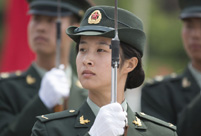 Chinese Kung Fu charms Silicon Valley
Chinese Kung Fu charms Silicon Valley
 Tranquil Yankou ancient town
Tranquil Yankou ancient town
 Lake Geneva: A show of swans
Lake Geneva: A show of swans
 Beautiful sunset over the Irtysh River
Beautiful sunset over the Irtysh River
 Qingjing Mosque: Witness of the ancient Maritime Silk Road
Qingjing Mosque: Witness of the ancient Maritime Silk Road
 Neiliansheng – more than 100 years of fashion
Neiliansheng – more than 100 years of fashion
 Golden retriever feeds baby African lions
Golden retriever feeds baby African lions
 Strange rocks in Lama Mountain
Strange rocks in Lama Mountain
 First overseas "China-standard" electric railway laid
First overseas "China-standard" electric railway laid
 College graduate launches organic agricultural cooperative in hometown
College graduate launches organic agricultural cooperative in hometownBEIJING, May 26 -- China's ethnic minorities have fully enjoyed and effectively exercised their basic rights, according to a white paper published on Monday.
The political rights of ethnic minorities are fully guaranteed, including legislative power and the right to use their own spoken and written languages, says the white paper titled "Progress in China's Human Rights in 2013" issued by the Information Office of the State Council.
The socioeconomic rights of ethnic minorities are fully protected with the state continuously increasing funds to promote socioeconomic development in those areas, says the white paper.
In 2013 the GDP of the Tibet Autonomous Region reached 80.767 billion yuan, growing by 12.5 percent over the previous year; the per capita net income of farmers and herdsmen was 6,578 yuan, increasing by 15 percent over the previous year and well into the 11th year of double-digit growth; and the per capita disposable income of urban residents reached 20,023 yuan, up by 11.1 percent compared with 2012, it adds.
Ethnic minority cultures and cultural undertakings in areas inhabited by ethnic minorities prospered, according to the white paper.
The state established an experimental area for the protection of the culture and ecology of ethnic minorities living in southwestern Guizhou Province, effectively promoting the overall conservation of the intangible cultural heritage in ethnic minority areas.
People of ethnic minority groups in Xinjiang enjoy freedom of religious belief and their customs and social mores are fully respected, it says adding religious believers from ethnic minority groups in Xinjiang are entitled to conducting normal religious activities.
Currently there are ten minority groups in Xinjiang that mostly believe in Islam, with a total population of around 13.7 million. In Xinjiang there are also 120,000 Buddhist believers, with 53 venues for activities and 326 staff members; about 60,000 Protestant followers and 374 clergymen; 6,000 Catholic followers, with 20 venues for activities and 25 priests; 1,000 Orthodox believers with three venues and two priests; and 300 Daoist believers with one venue for activities.
The cultural legacies of Tibet are effectively protected, and the local religion and traditional customs and social mores are respected, says the white paper.
Currently Tibet has 4,277 sites of cultural relics. The Potala Palace, Norbulingka Summer Palace and Jokhang Temple have been included in the UNESCO World Heritage List; Lhasa, Shigatse and Gyantse have been entered on the national list of historical and cultural cities.
 Opening ceremony of 67th Cannes Film Festival
Opening ceremony of 67th Cannes Film Festival Pulse of Xiamen - Int'l Yoga art festival in May
Pulse of Xiamen - Int'l Yoga art festival in May Photo story: Life of a scrap metal recycle worker
Photo story: Life of a scrap metal recycle worker Training of the PLA's first female honor guard
Training of the PLA's first female honor guard China's 10 must-see animations
China's 10 must-see animations Female bodybuilders show their beauty of fitness
Female bodybuilders show their beauty of fitness A taste of Harbin cuisine
A taste of Harbin cuisine A bite of Jiang Nan
A bite of Jiang Nan Who is China's campus beauty queen?
Who is China's campus beauty queen? 8 great movies to watch with your mom
8 great movies to watch with your mom China's most luminous celebrities
China's most luminous celebrities Newly recruited police in Hetian hold drill
Newly recruited police in Hetian hold drill  Bird-men compete flying in Hong Kong
Bird-men compete flying in Hong Kong  The 'Chinese Dad'
The 'Chinese Dad' Shanghai locals bid farewell to childhood memories
Shanghai locals bid farewell to childhood memoriesDay|Week|Month